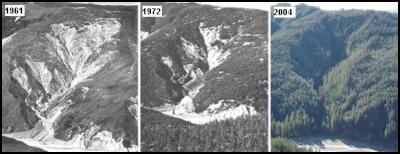Researchers have answers for East Coast gully
Researchers have answers for East Coast
gully grief

New research has shed light on just how bad the East Coast's gully worries are, and how they can best be treated.
The East Coast is renowned for its erosion problems, particularly gully erosion; but until recently the number, size and location of these gullies was unclear. Regardless of their size, as the most active and destructive of the erosion processes, gullies are a scourge on the landscape. The gully-derived sediment loads in the Waipaoa, Uawa and Waiapu rivers is greater than that of many of the world's major river systems, and is literally smothering downstream ecosystems and exacerbating flooding.
A recent study by Landcare Research shows that gullies began to form within 30 years of clearing indigenous forest for conversion to pasture. By the late 1950s, there were 3,780 individual gullies present in the region. Despite extensive reforestation, there are still about 2,000 gullies on pastoral land that require stabilisation treatment.
Having established their location and size, researchers then established how long it takes for replanted gullies of different sizes to stabilise. Initial results show the most successful treatment option is blanket afforestation.
"Although not the most popular option with landowners, there is little doubt that for gullies of less than 10 hectares, reforestation affords the quickest results," research leader Mike Marden says.
"Gullies up to one hectare in size have an 80% chance of successfully closing within ten years of planting. The larger the gully, the lower the chance of successful treatment. That's why it's essential to prioritise and target gully systems before they reach a critical size beyond which treatment is more expensive and less certain."
Mr Marden says the choice of trees for reforestation is important.
"We have found that planting poplar poles and willows is effective if the gullies are less than a hectare in size. But for larger gullies of 10*15 hectares blanket reforestation together with encouraged reversion, though slow, works best."
Insights into likely impacts of climate change Mr Marden says Cyclone Bola, which struck the East Coast in 1988, provided insights into how forested and non-forested gullies might respond in extreme rainfall.
"Typically, non-treated gullies expanded in size, while treated gullies attaining canopy closure remained unaffected.
"The lesson for landowners is that the consequences of doing nothing include significant losses of productive land. Meanwhile the cost of repairing off-site damage caused by sediment supply from gullies will increasingly be borne by ratepayers.
"If Cyclone Bola is typical of what we might expect from climate change, landowners may be wise to consider future-proofing their gullies," Mr Marden says.
ENDS


 Fix & Fogg: NASA Hand-picks Kiwi Nut Butter Brand To Travel To Space In NZ First
Fix & Fogg: NASA Hand-picks Kiwi Nut Butter Brand To Travel To Space In NZ First Citizens of the Sea: Sailors To Revolutionise Our Understanding Of Pacific Biodiversity
Citizens of the Sea: Sailors To Revolutionise Our Understanding Of Pacific Biodiversity Netsafe: Making A Splash With Online Safety: Netsafe Launches New Flagship Programme For Kids
Netsafe: Making A Splash With Online Safety: Netsafe Launches New Flagship Programme For Kids NZGBC: Flood Resilience PhD Student Widi Auliagisni Named Future Thinker Of The Year 2024
NZGBC: Flood Resilience PhD Student Widi Auliagisni Named Future Thinker Of The Year 2024 Business Canterbury: European Free Trade Agreement A Game-changer For Canterbury
Business Canterbury: European Free Trade Agreement A Game-changer For Canterbury Business Canterbury: Urges Council To Cut Costs, Not Ambition For City
Business Canterbury: Urges Council To Cut Costs, Not Ambition For City



